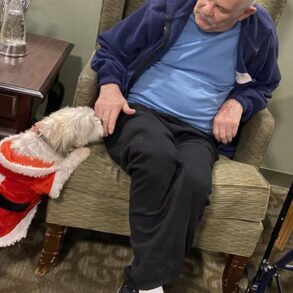
Behind every Olympic gold medal is a team of coaches, trainers, and specialists who help the world’s most elite athletes live out their dreams. Team USA’s women’s gymnastics team is no exception, but they have a unique member on their support squad.
Beacon, Team USA’s therapy dog, first made headlines during the Olympic Trials earlier this summer, as pictures and videos of him interacting with star gymnasts like Simone Biles, Suni Lee, and Jordan Chiles went viral. Although Beacon couldn’t be at the Olympics because of logistical reasons, the 4-year-old golden retriever still played a pivotal role in the team’s success leading up to the Paris Games.
What is a therapy dog?
According to the 2021 AAHA Working, Assistance, and Therapy Dog Guidelines, there are two types of therapy dogs: those who perform animal assisted activities (AAA), and those who perform animal assisted therapy (AAT).
Beacon’s job falls under the AAA category because, unlike service or emotional support animals, Beacon’s purpose isn’t to “help persons with a diagnosed psychological or physical limitation who benefit from interaction with a dog.” Rather, as a therapy dog, Beacon is a “happiness-delivery” animal, who specializes in “de-stressing interactions with people.”
Therapy dogs are categorized separately from assistance dogs, and a key difference between the two is in their selection process.
While both assistance dogs and therapy dogs can be independently trained, it’s not uncommon for nonprofits that specialize in the training of assistant dogs to also house their own breeding programs. Organizations like these select the best potential assistance dogs based on health, trainability, and temperament evaluations to test their suitability to the work they’re being trained to do.
On the other hand, therapy dogs like Beacon can be pets whose owners are a part of volunteer therapy teams overseen by registered AAI (animal-assisted intervention) programs or health/human service providers. Beacon and his trainer, former rhythmic gymnastics coach Tracey Callahan Molnar, fall under the pet-to-therapy dog pathway.
Molnar, who is a longtime advocate of and participant in animal volunteerism efforts, formed an emotional connection with Beacon even before adopting him in 2020, and saw his potential for therapy work early on in his life. After the passing of her first therapy dog, Tulsa, in 2019, she hoped Beacon would be cut out for therapy work; although therapy work looks fun (and makes for great pictures!), it’s not a role just any dog can fill, and certainly not a job they can be forced into.
Beacon’s qualifications
Although the Working Dog Guidelines guidelines note that no specific training is required of pet dogs that become therapy dogs. But because their calmness and sociability are the focal points of their jobs, these dogs often undergo obedience training to prepare for certification through their AAI program, which requires a standardized behavior evaluation.
Additionally, potential therapy dogs should be tested in the working environments in situations they may encounter to ensure they demonstrate minimal signs of behavioral stress and good-to-excellent social behavior without threatening their safety or the safety of others. Reliability, predictability, and controllability are the names of the game.
In other words, a particular temperament is required of therapy dogs, and not just any dog can make the cut. Beacon, however, excels in his role.
In an interview with USA Today, Molnar said that Beacon has a “very good” ability to sense stress in people, making him particularly well-suited for this work.
Sociability and a friendly temperament is only part of the equation, though; people skills are of the utmost importance when it comes to therapy work. Fortunately, according to Molnar, Beacon likes dogs, but really loves people.
A team effort
Although Beacon is the poster pet of Team USA’s mental health resources, he’s not alone. He’s a member of a roughly 16-dog team compiled of dogs of various breeds, colors, and sizes that have been introduced in recent years following abuse scandals and mental health testimonies shared by elite gymnasts like Simone Biles, as well as athletes’ requests for increased mental health support.
According to Jill Geer, chief communications and marketing manager at USA Gymnastics, these athletes now have broader access to mental health resources in addition to more common resources like athletic training and nutritional support.
Photo credit: © ccahill E+ via Getty Images Plus
Disclaimer: The views expressed, and topics discussed, in any NEWStat column or article are intended to inform, educate, or entertain, and do not represent an official position by the American Animal Hospital Association (AAHA) or its Board of Directors.
This post was originally published on this site be sure to check out more of their content.















































